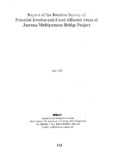Report of the baseline survey of potential erosion and flood affected areas of Jamuna Multipurpose Bridge Project
Citation
Chowdhury, P. K., Rafi, M., Jakariya, M., & Islam, S. (1997, April). Report of the baseline survey of potential erosion and flood affected areas of Jamuna Multipurpose Bridge Project. Research Reports (1997): Economic Studies, Vol - XII, 411–415.Abstract
This is a reoort on the baseline survey of the households within the area demarcated by the Jamuna
Multipurpose Bridge Authority (JMBA). This area spreads over 12 km to the north and 10 km to the south
of the bridge. This area covers both charland and mainland. In the mainland. The survey area covers half
a kilometer inland from the riverbankline on both sides of the river. The survey covers households in 44
chars and 132 villages which spread over 13 unions and 5 than as under the two districts. namely Tangail
and Sirajganj. JMBA issued identity cards to those households whose lands were acquired in 1992 and 1993 for the
bridge. About 7% of the households covered by this survey are holders of these identity cards. The
percentage of households with ID cards is 9.3% for Tang ail and 4.25% for Sirajganj. The total number of
households under this survey is 24,035. These households have a population of 129,031 and the
average size of these households is 5.4. Of these households 6.9% are female headed. The survey covered 44 chars of different age and size. The age (habitation period) of these chars varies
from 4 to 65 years. These chars have a number of community facilities such as mosque, madrasah,
primary schools etc. ln certain unions of Sirajganj and Tangail districts, there is a concentration of
handloom weaving factories. The survey area has a total of 416 factories with a total of 3875 workers
under them. The value of land per decimal in these chars as reported by the local people varies from
Tk.30 to 1300 in the case of agricultural land and from Tk. 30 to 1200 in the case of homestead land.
The average size of households under the survey is 5.4 for Tangail. 5.3 for Sirajganj and 5.1 for erosion
affected areas. The percentage of household members within the age group of 15-59 is 50.3 in the
survey area while this percentage is 49.24 at the national level (1991 census). The population pyramid of
the survey area as a whole is almost symmetrical with that of the national level. The unmarried
population of the households under the survey constitutes 55.7 and the married 39.9. The difference
between these percentages for the charland and that for the mainland is small.

